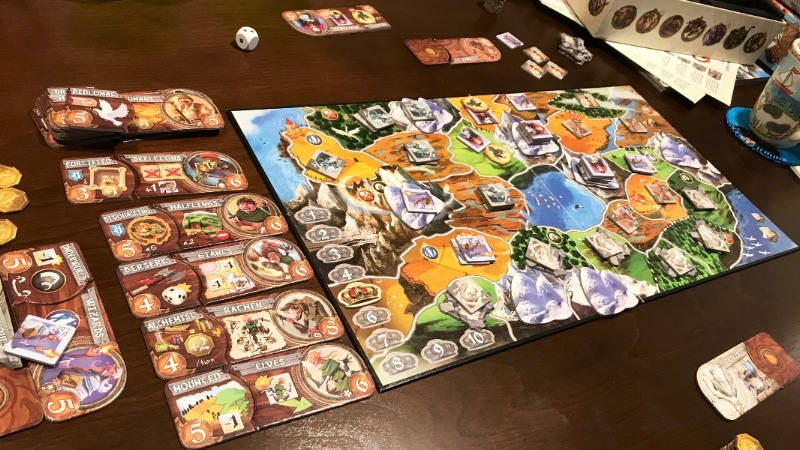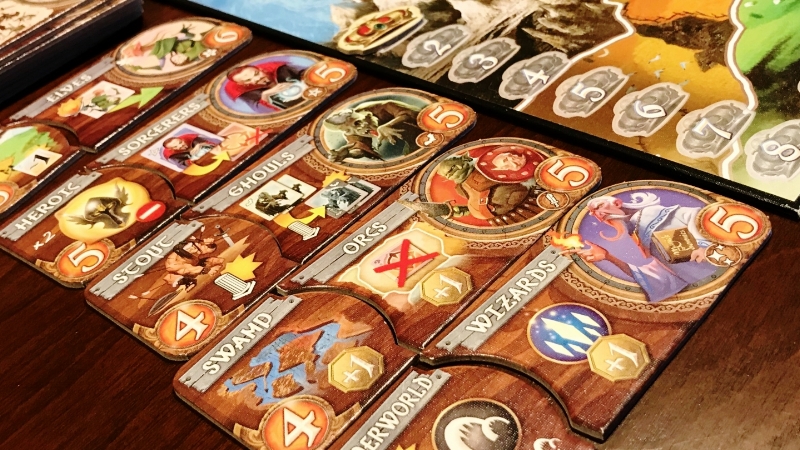Small World
Designed by Philippe Keyaerts
Artwork by Miguel Coimbra & Cyrille Daujean
Published by Days of Wonder - 2009
2-5 Players ~ 40-80 Minutes
Review by Jack Eddy
For Peter
Among the towering giants of the industry, there stand certain iconic games that have managed to straddle the line between niche and mainstream. At first, Small World may seem the unlikeliest of this group (too strategic for the casual, too simple for the core), yet it’s popularity persists, and upon closer examination, it’s not hard to understand why; straddling that line is exactly what Small World is meant to do.
The Score
Small World pits players against one another, vying for control of regions in a landmass fine tuned to be just about 15% too small, meaning that, whether you like it or not, you are bumping heads with your neighbors, which makes sense, since controlling territories nets you coins every round and coins are both a currency and your points in the game.
The first and most important decision you’ll make on your first turn is selecting one of several races on display, determining your abilities and number of units that you can conquer regions with. Interestingly, Small World handles balance of variable powers through a sort of bidding system, where you can take the lowest race on display for free, or drop a coin on each race that you pass up. If you pick up a race that one or more players passed, you get those sweet, sweet coins. Considering that players will return to selecting races several times throughout a game (more on that later), the incentive to pick less powerful races can be substantial.
From there, the core gameplay is unexpectedly simple; on your turn, you can withdraw as many of your units from regions as you like (leaving at least one if you want to retain control), then conquer regions adjacent to you by slamming your units into them. Once you run out of units or decide not to expand, you end your turn, get yer gold, and redistribute your units amongst your controlled territories.
This redistribution is important because, unlike most “area control” games, entering territories (empty or otherwise) just requires you to spend 2 units + 1 for each other piece of cardboard residing there. Is there a mountain token? Spend 3 units. Is there a mountain token and 2 enemy units? Spend 5. If you happen to conquer an opponent’s territory, one of their units dies a horrible (yet honorable) death, while the remainder retreat back to the player so they can be used during future, totally not vengeance-related, conquests.
Harmony
The magic of Small World comes from the variable player powers that you purchase throughout the game. From two shuffled stacks, pairings of fantasy races and abilities are created, each side granting their own abilities. For instance, Flying means you don’t have to obey adjacency, Orcs give you points for attacking players, and Flying Orcs means you have a really nasty problem on your hands.
These combinations present a huge amount of flavor and replayability, which, given the highly stylized artwork of the game, the particularly preposterous combinations are especially welcome. Dragon-Riding Halflings? You bet. Seafaring Ghouls? Awesome. Underground Wizards? Saw them live in ‘72; changed my life.
Probably the coolest system in Small World is that as you further expand your units, you will begin feeling thin, stretched, like butter scraped over too much bread. At this point, you can choose to go into decline, flipping your units upside down and choosing a new race/ability mashup on the next turn. Your forsaken race will still net you money for controlling a territory, but they are forever immobilized, diminished, decaying until they are eventually wiped out.
N’Sync
For all the fighting, there is a beautiful harmony to Small World; the core concept is simple and easily grasped, and all the powers simply feel in tune, resonating wonderfully in concept and theme. Seafaring races behave identically to everything else EXCEPT that you can conquer the water territories on the board; makes sense! Dwarves have less units, but double the amount of production on mines even while in decline; great!
Within this narrow framework, there is a staggering amount of variability, presenting interesting combinations that are as dynamic and wild as the rich fantasy setting, but it’s so damn intuitive that it never feels overwhelming.
Acoustics & Tone
Everything in this game is flippant, and I love it. From the artwork to the way the powers reference the theme, this game is as much a loving parody as it is an homage to classic fantasy tropes, but done with far more elegance than is typically found in this hobby. Too often, characters in games look like statues, devoid of action and life, evoking no personality, which in turn makes their worlds seem hollow. Not so here; Small World is vibrant, alive, and every character, and even the very landscape, seems to have an (albeit negative) opinion of everyone else.
Furthermore, this flippancy reflects your state of mind in Small World. In many area control games the stakes are high, and if someone brings their dudes to your doorstep, you feel personally attacked. But here, if you lose your region, you get most of your units back and can happily reclaim it or shove off in a different direction next turn. This is one of the reasons that Small World has had such broad success; that in spite of the core concept being full of confrontation, conflict feels fun rather than mean.
To me, this is reflective of a success in the design, and what separates Small World from so many other area control games in the wild. From the mechanics to the artwork, and even to the incredible insert and the way the tokens feel in your hands, everything in Small World feels so intentional, crafted with function and aesthetic in mind.
Sour Notes
For all of it’s saturated beauty, not all is sunshine and violent daisies in Small World. Once you play a few times, you’ll realize that experienced players can bust out a game in 30 to 45 minutes. “But that’s a good thing!” you say, which is true. The problem is that all of the materials that you took out of the box, all of the tokens and maps and cardboard… they can make the game feel much more to contend with than the lighter heart of the game deserves.
Whether it’s after 5 games or 50, it’s easy to start seeing the “variety” that you initially loved as minor riffs on the same song and dance. The races and powers that were so imaginative and thematic are now just abstract calculations for how best to capitalize on your turn. In a world of way more complex and immersive games, it’s easy to become jaded to this Small World.
And while there are way more creative and dynamic powers in the expansions (and believe me, there are a ton of expansions), the addition of new content undermines the elegance of the original design; whether it’s because it just won’t fit into the original, perfectly sculpted insert, or it’s because 15 new races made it so you couldn't keep track of who does what without 6 different reference sheets, the game loses it’s polish, making it a bit too much of a hassle to bother with for the level of experience it provides.
*After owning several expansion, modules, and other Small World paraphernalia, I can definitively say that the Base Game, or maybe the Base Game + a few of the purely race + power expansions is the way to go.
Furthermore, the same things that give Small World such broad appeal hold it back from really shining in any one light. Sure, the conflict is tolerable for people who normally hate combat, but it is still a conflict heavy game. And for people who LOVE conflict? Combat enthusiasts (ninja’s, vikings, Jeffery, etc…) will find the lack of stakes a bit lackluster.
In many ways, Small World feels like a compromise, something everyone can enjoy, but fewer gamers will love.
A Well Crafted Pop Song
That said, there is a comfort to Small World, and it still holds an important role in my collection as well as in my heart.
Years ago, when I first played Small World in my friend Peter’s apartment, it was the biggest looking game I’d ever played. Tons of powers and combinations and tokens, with maps specific to each player count; it looked like the most complicated thing that I’d ever seen. But within a few short rounds, (with my Forest Amazons as the definitive MVP) I had a firm handle on the mechanics of the game and the rest was exploration of strategy and discovery of clever design.
My final conclusion? Small World WAS a huge game, the biggest game ever, something with so many resonant and cool aspects that completely dwarfed (dwarved) contemporaries like Settlers of Catan, Carcassonne, and Dominion; yet it never felt beyond my grasp. Unlike other, more nuanced and hardcore games with similar styles of area control, Small World is inviting, approachable, and eases players into foundational concepts that are often completely obtuse for newcomers to the board game world.
The leap from Carcassonne to Cthulhu Wars is a big one, but is much more manageable with Small World in between.
That is the success of Small World, and why it’s remained such a constant touchtone for hobbyists of all types. Inevitably, many people grow beyond it’s grasp, and admittedly, it doesn’t hit my table nearly as often as it once did, but it was invaluable in my gaming journey, and still remains a satisfyingly solid game in my collection that is worthy of returning to a few times a year for a reminder that fun can be simple, innocent, and specific.
Whether it’s with new players, taking their first steps beyond the gateway into the world of gaming, or it’s with longtime friends and gamers who want a polished experience that feels big without the baggage and time that comes along with it, Small World continues to hit the table. And each time I see those unmistakable character designs, gaze over the saturated and yet-unclaimed territories, and select my initial power combo full of potent thematic and strategic implications, I’m reminded that Small World is designed exactly the way that it needed, and needs, to be.
Addendum - Digital Music: While I’m very much a physical components kind of guy, the Small World app is beautiful and resolves the issue of setting up and managing such a big game that otherwise moves so quick. It hasn’t replaced the tabletop version for me, but it is easily one of my favorite tabletop gaming apps that allows the strengths of the game (it’s beautiful artwork and fast/flippant gameplay) to shine.
Vote on an upcoming review!
TCbH provides thoughtful and entertaining reviews, interviews and recommendations in audio, written, and video formats.
We are entirely audience supported, and one way of saying thank you to our patrons is to let them have a say in our content.
Help us decide which FFG Classic to tackle in an upcoming written review:
Game of Thrones 2nd Edition
Battle for Rokugan
Star Wars: Imperial Assault
Reiner Knizia's Lord of the Rings
Voting closes August 17th. Patrons can vote by emailing cardboardherald@gmail.com, posting in the comments on youtube, or reply to the post on our patreon. Thank you for your support!










